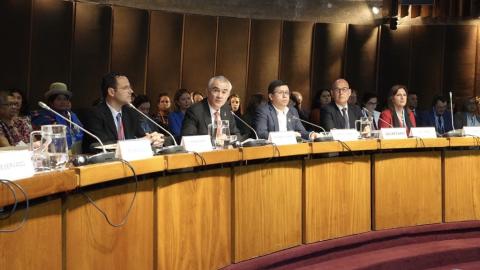News
Age is one of the structural elements in the social inequality matrix in Latin America and the Caribbean, which overlaps with and potentiates other core elements, such as socioeconomic status, gender, ethnic-racial origin and territory, according to one of the chapters in the Social Panorama of Latin America 2016 annual report, which was presented recently by the Economic Commission for Latin America and the Caribbean (ECLAC).
“Each stage of the life cycle presents specific opportunities, challenges and risks,” ECLAC indicates in the chapter entitled “The social inequality matrix: Age as an axis of social inequalities,” in which diverse gaps are identified in four stages: childhood and adolescence, youth, adulthood and old age.
When compared with people in other phases of the life cycle, children live more often in situations of shortage and deprivation, the Commission warns, which entails grave consequences for their future.
This group is overrepresented in lower-income quintiles and there are striking gaps within the child population if other axes of social inequality are taken into account. For example, when analyzing infant mortality data by ethnicity, it can be seen that indigenous children show higher rates than non-indigenous children in the 11 countries studied.
Youth is another critical stage, ECLAC emphasizes, since social inequalities can either be widened or reduced at that time. In this phase, issues that will mark adulthood are defined: it is expected that young people will finish their studies, acquire work skills, begin a labor endeavor under suitable conditions and, in many cases, establish or consolidate their own families. In the Latin American reality, however, these phases and transitions often do not follow a linear path, but instead constitute times at which inequality is reproduced and magnified.
The study highlights that between 2002 and 2014, the percentage of young people between 20 and 24 years of age that finished secondary school increased, both for men (rising from 39.6% to 55.6%) and women (from 44% to 62.2%). This increase was particularly noteworthy in rural areas (from 18.7% to 38.4% in the case of men and from 20.4% to 42.2% in the case of women).
Despite these advances, evidenced by the figures, there is still a high percentage of youth of both sexes that has not completed secondary school, an educational level that is considered crucial for breaking the intergenerational cycle of poverty and expanding their possibilities to access a decent job. In addition, there is still a significant gap in terms of finishing secondary school between young people in urban and rural areas, between indigenous and non-indigenous youth, and between Afro-descendant and non-Afro-descendant youth, ECLAC sustains.
One group that prompts special concern are the young people who neither study nor are employed in the labor market, which is made up mostly of women.
Although the percentage of young people in this situation declined on average between 2002 and 2014, in the five countries of the region that have information on ethnic origin (Bolivia, Brazil, Chile, Ecuador and Guatemala), the decline was not uniform across the different population groups, being much more modest for women than for men, while indigenous women made the least progress.
The Social Panorama 2016 also emphasizes that the region is undergoing a period of profound demographic transformation, characterized by steady population ageing.
In this context, the educational achievements made during adolescence and youth have a significant impact on the position attained in the labor market in the long term, which in turn affects access to contributory retirement pensions.
According to the report, there are very striking differences in the reception of contributory pensions by education level: according to the simple average among eight countries with information available, 30% of men 65 or older who did not complete their primary education had a pension in 2014, a percentage that rose to 66% in the case of those who had completed secondary school or beyond. For women, these figures were 21% and 62%, respectively, which lays bare a gender gap that is the result of women’s more precarious insertion in the labor market.
The chain of inequalities from childhood to old age requires, according to ECLAC, that officials adopt a life cycle approach in designing and implementing public policies. “The life cycle approach places individuals at the center of public action from birth to the end of life, recognizing that their needs change over a lifetime and that the individual is the starting and end point of social policy,” the document states.
For that reason, “from an institutional standpoint, this means recognizing and dealing with the specific needs and risks of each stage in the life cycle, while also coordinating policies focused on these different stages,” the text concludes.



